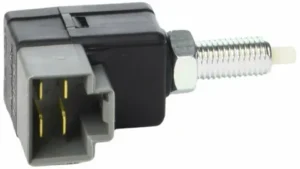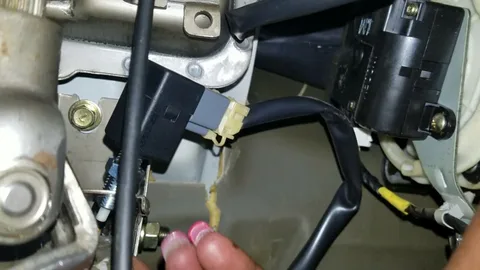If you drive a Hyundai, it’s important to ensure that all your vehicle’s components are functioning properly. One crucial component to watch is the Hyundai Brake Light Switch. This small but vital part ensures that your brake lights illuminate when you press the brake pedal. In this blog post, we will discuss how to troubleshoot issues with your Brake Light Switch, common symptoms of a faulty switch, steps to diagnose problems, how to replace the switch if needed, tips for preventing future failures, and maintenance tips for your Hyundai’s brake system.
Understanding the Toyota Hilux Indicator Switch
The Toyota Hilux Indicator Switch is critical in operating the vehicle’s turn signals and headlight dimming features. Similar to the brake light switch in a Hyundai, the indicator switch is a pivotal part of the vehicle’s safety systems, ensuring that other drivers know your intentions on the road, whether you’re turning or changing lanes.
Understanding how the Toyota Indicator Switch works provides insight into the interconnected nature of vehicle electronics and the universal importance of maintaining these systems for road safety. The switch is typically located on the steering column and activates the vehicle’s turn signals, headlights, and sometimes wiper functions. The proper functioning of the indicator switch is vital for signalling to other drivers, and it, like the brake light switch, is essential for preventing accidents and ensuring smooth, safe driving experiences.
While the specific troubleshooting and replacement processes for the Toyota Indicator Switch may differ from those of the Brake Light Switch, the overarching theme remains the same: maintaining your vehicle’s electrical systems is crucial for road safety and legality. For owners of the Toyota Hilux or any vehicle, understanding and promptly addressing issues with components like the indicator switch can help ensure the longevity and reliability of your vehicle’s signalling systems.
Common Symptoms of a Faulty Brake Light Switch
Several distinct symptoms can alert you to the problem when dealing with a faulty Brake Light Switch. Firstly, the most obvious sign is when the brake lights fail to illuminate after pressing the brake pedal. This poses a significant safety risk by failing to alert drivers behind you that you’re slowing down or stopping. Still, it can also lead to traffic citations for malfunctioning vehicle lights. Conversely, another symptom is the brake lights staying illuminated continuously, regardless of whether the brake pedal is engaged. This can drain the battery and confuse other drivers, increasing the risk of accidents.
Another less apparent symptom involves issues with the vehicle’s shift lock feature. A malfunctioning brake light switch can prevent you from shifting out of park, as many vehicles require the brake pedal to be pressed before shifting gears. Additionally, if you experience unexpected problems with your cruise control, such as not engaging or disengaging, the brake light switch could be the culprit. The system relies on the switch to disengage the cruise control when the brakes are applied so that a faulty switch can disrupt normal cruise control operation.
These symptoms can indicate that the Brake Light Switch is not functioning correctly and requires attention. Ignoring these signs can lead to safety issues and potential legal problems, underlining the importance of promptly addressing brake light switch malfunctions.

Step-by-Step Guide to Diagnosing Toyota Hilux Fog Light Switch Issues
Diagnosing issues with the Toyota Hilux Fog Light Switch is essential for maintaining optimal visibility during adverse weather conditions. Here’s a comprehensive guide to help you troubleshoot:
1. Visual Inspection:
Start by visually inspecting the fog light switch. Check for signs of physical damage, such as cracks or worn-out buttons. Also, examine the surrounding area for loose wires or connections.
2. Test the Switch:
Turn on the ignition and test the functionality of the fog light switch. If the switch feels loose or unresponsive, it might indicate internal damage or a faulty connection.
3. Check Fuse and Relay:
Locate the fuse and relay associated with the fog lights in your vehicle’s fuse box. Use a multimeter to check if the fuse is blown or the relay is faulty. Replace them if necessary.
4. Inspect Wiring and Connections:
Carefully inspect the wiring harness connected to the fog light switch. Look for any signs of fraying, corrosion, or loose connections. Ensure that all connections are secure and properly insulated.
5. Test Power Supply:
Use a voltmeter to test the power supply to the fog light switch. Check for voltage at the switch terminals while it’s turned on. If there’s no power, trace the wiring back to the source to identify any issues.
6. Check for Grounding Issues:
A poor ground connection can also cause problems with the fog light switch. Test the continuity between the switch and the vehicle’s chassis to ensure a solid ground connection.
How to Replace Your Hyundai Light Switch?
Replacing a Brake Light Switch is a task that can be undertaken by individuals with a bit of mechanical know-how. Before you begin, ensure a new brake light switch specific to your Hyundai model and the necessary tools, typically including a screwdriver and pliers. First, ensure the vehicle is parked on a level surface and the ignition is turned off to prevent electrical mishaps.
Begin by locating the brake light switch near the top of the brake pedal assembly. In some Hyundai models, you might need to lie on your back and use a flashlight to spot it more easily. It’s usually attached to a bracket that holds it in position and connected to the brake pedal mechanism.
The next step involves carefully disconnecting the electrical connector from the old switch. This connector should slide or clip off, but be gentle to avoid damaging the wiring. With the connector detached, unscrew or unclip the old switch from its mounting bracket. Depending on your Hyundai model, this may require pliers or a screwdriver.
Once the old switch is removed, compare it with the new one to ensure compatibility. Mount the new brake light switch onto the bracket, securing it as per the original setup. After mounting, reattach the electrical connector to ensure it snaps or slides securely into place.
Finally, it’s crucial to adjust the new switch if necessary. Some models require manual adjustment to ensure the brake lights activate at the correct pedal pressure. Test the installation by pressing the brake pedal and checking if the brake lights illuminate as expected. Follow your vehicle’s manual for specific instructions or consult a professional if adjustments are needed.
Preventing Future Brake Light Switch Hyundai Failures
One of the primary causes of Brake Light Switch Hyundai failures is wear and tear over time. Constant usage can lead to the deterioration of the switch mechanism, resulting in malfunctioning or non-responsive brake lights. Additionally, exposure to extreme temperatures and moisture can accelerate this process, making it essential to monitor the condition of the switch regularly.
Addressing Electrical Issues
Electrical problems also contribute to brake light switch failures in Hyundai vehicles. Corrosion or loose connections in the wiring harness can disrupt the flow of electricity to the switch, causing it to malfunction. Routine inspections and maintenance of the electrical components can help detect and resolve these issues before they escalate.
Ensuring Proper Installation
Improper brake light switch installation during manufacturing or replacement can lead to premature failures. Following the manufacturer’s guidelines and recommendations is crucial when installing a new switch. This includes proper alignment, connection securing, and testing functionality to ensure optimal performance.
Regular Maintenance and Inspection
Regular maintenance checks should include inspecting the brake light switch for any signs of damage or wear. This proactive approach allows drivers to identify potential issues early on and take corrective action to prevent failures. Additionally, keeping the brake system clean and free from debris can help prolong the lifespan of the switch.
Tips for Maintaining Your Hyundai’s Brake System
Ensuring your Hyundai’s brake system is in top condition is crucial for your safety on the road. Regular maintenance not only prolongs the life of your brakes but also enhances overall vehicle performance. Here are some essential tips to keep your Hyundai’s brake system in excellent shape:
Regular Inspections:
Schedule routine inspections of your brake system to catch any issues early on. Consider signs such as squeaking noises, grinding sensations, or a soft brake pedal. These could indicate worn brake pads, damaged rotors, or fluid leaks.
Brake Fluid Check:
Check the brake fluid level regularly and top it up if necessary. Low brake fluid can compromise braking efficiency and lead to brake failure. Ensure the brake fluid is clear and free of contaminants. It may be time for a flush and refill if it appears dirty or discoloured.
Brake Pad Replacement:
Monitor the thickness of your brake pads and replace them when worn down to the minimum recommended thickness. Neglecting worn brake pads can damage other brake components and reduce stopping power, increasing the risk of accidents.
Rotor Maintenance:
Inspect the brake rotors for signs of wear, such as grooves or uneven surfaces. Rotors should be smooth and evenly worn. If you notice any abnormalities, have them resurfaced or replaced as needed to prevent brake performance issues.
FAQS
Q: What signs indicate a problem with my Brake Light Switch?
A: Issues to watch include brake lights that do not turn on when you press the pedal, brake lights that remain on without the pedal being pressed, difficulty shifting the vehicle out of the park, and cruise control malfunctions.
Q: Is it feasible for me to fix the Hyundai Brake Light Switch on my own?
A: With some mechanical knowledge and the right tools, you can replace the Hyundai brake light switch yourself. It involves locating the switch near the brake pedal, disconnecting the electrical connector, removing the faulty switch, and installing the new one with proper adjustments. However, if you’re not confident in your abilities, seeking professional help is advisable.
Q: What can I do to avoid future Brake Light Switch failures?
A: Regular maintenance such as keeping the brake pedal area clean, avoiding excessive force on the brake pedal, conducting routine checks of the brake light function, and staying updated with manufacturer recalls, can help prevent future issues.
Q: How often should I inspect my Hyundai’s brake system?
A: Regular inspections by a professional mechanic should be a part of your vehicle maintenance routine, especially before long trips or if you experience any of the symptoms of a faulty brake light switch.
Conclusion
Ensuring the optimal performance of your Hyundai Brake light Switch is paramount for vehicle safety and compliance with road regulations. You can avoid the common pitfalls associated with this crucial component by diligent troubleshooting, correctly diagnosing issues, and engaging in preventative maintenance. Addressing symptoms early and taking proactive steps based on the advice provided can significantly reduce the likelihood of future malfunctions. Whether you decide to tackle replacement and adjustments on your own or seek professional assistance, understanding the importance of the brake light switch and its role within your vehicle’s brake system is key. Remember the tips for maintaining your Hyundai’s braking efficiency and remember that regular checks can lead to early problem detection, ultimately ensuring a safer driving experience for you and others on the road.
| Other Good Articles to Read |
| Blogs-Peoples |
| Bryan Smith Blogs |
| intellect blogs |
| the fault in our blogs |
| blogs eu |
| oz forums |
| recruitment blogs |
| zet blogs |
| id blogs |
| Blog Studio legale |
| blogs map |
| Related Business Listings |
| Contact Directory |
| Local Business Profiles |

